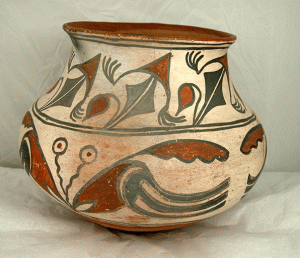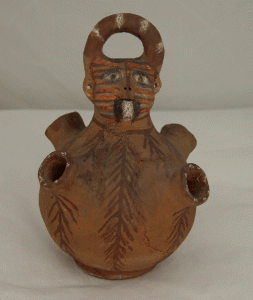Last semester I was working on individual inventory sheets for the pottery in the museum. These sheets have as much documented information about the vessel as possible. Some of the information is the description of the vessel: a descriptive title, object type, medium description, dimensions, and condition. I would like to share some of the different descriptive titles and use of the vessel you will come across when you visit the museum or when you view the different pueblo tabs on the webpage.

San Ildefonso. Olla. c. 1900-20. Red and black on white on red clay. 26.5×31 cm. (dia.) Gift of Mrs. Charles H. Woodard. 1965.1.27
The olla is a relatively large vessel used for collecting, carrying, and storing water. Since the beginning of the 18th century they were almost always made with a depression on the bottom so that it may be carried on the head. The ollas served as a natural refrigerator, the porosity of the paste allowed the contents to cool by evaporation, making it a valuable commodity in the arid southwest.
Bowls are vessels with an opening at approximately the greatest width, whereas Jars have a narrow opening and are usually taller.
Large storage jars have a narrow mouth to facilitate coverage. Storage jars that held grain have come down from the generations among the most plentifully preserved of all the pottery forms of the middle Historic period. This is because they remained relatively undisturbed in corners of back rooms.
Water jars are smaller and lighter than storage jars. They were used to scoop up water form a stream or river. They usually have a concave base so it could be carried on top of the head, often without using the hands.

Mojave. Effigy Jar. Dark red, black, white, and orange on red clay. 18.7×11.6 cm. (dia.) Gift of Mrs. Bessie T. Barnes. 1965.2.3
Ceremonial vessel and Effigy figures in animal and human shapes are rare. They vary considerably in form and use. They are used to hold the sacred corn pollen. Ceremonial ware was the least handled and usually remained carefully stored away. Ceremonial bowls generally are more exotic in their decoration, covered with sacred symbols of the Indians religious traditions; these include human and animal figures, emblems of natural phenomena—lightening, rain, clouds, and depictions of mythological beings such as the sky serpents.
Dough Bowls are the largest bowls, often capable of holding a week’s supply of bread dough for a family.
Preservation of vessels has come from the Indians reverence of their pottery.
BIBLIOGRAPHY
Frank, Larry and Francis H. Harlow. Historic Pottery of the Pueblo Indians 1600-1880. Schiffer Publishing Ltd. 1990.
